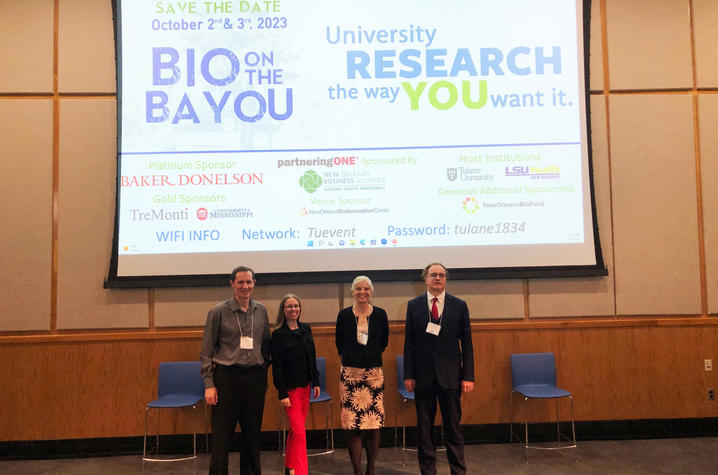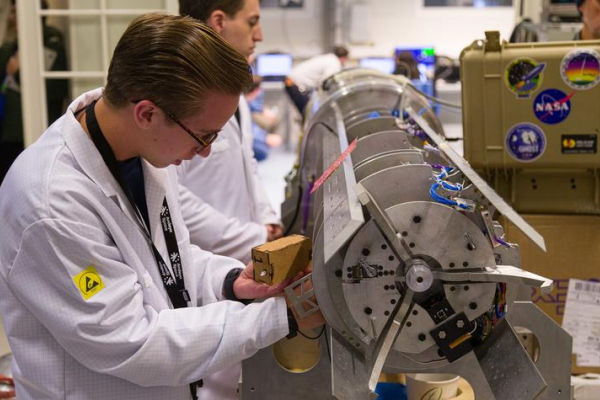UK researchers pitch infection, cancer, Alzheimer’s innovations to potential investors

Three University of Kentucky researchers presented their work in November at an academic bioscience showcase in New Orleans called BIO on the BAYOU.
This year’s conference focused on presenting “research the way you want it” to potential collaborators including investors and corporations. UK’s scientists also gave business pitches in 10-minute slots, with seven minutes for their presentations and three minutes for Q&A.
Sylvie Garneau-Tsodikova, Ph.D., a professor in the Department of Pharmaceutical Sciences in the College of Pharmacy and associate vice president for research, presented her work on antifungal agents.
“We’re really interested in trying to combat the fungal resistance problem. Current antifungals have resistance and toxicity problems. We’ve found a new family of compounds with great properties, but we need to understand the mechanism of action to reduce deadly fungal infections,” said Garneau-Tsodikova.
Oleg Tsodikov, Ph.D., also a professor in the Department of Pharmaceutical Sciences, presented collaborative work on a potential new drug to fight Ewing sarcoma, a rare type of cancer found mostly in bone and soft tissue in children. Tsodikov works on the project with Jurgen Rohr, Ph.D., vice chair and a professor in pharmaceutical sciences, and Markos Leggas, Ph.D., their former UK colleague and current faculty member at St. Jude Children’s Research Hospital.
“The drug is made up of molecules that are called mithramycin analogues. Mithramycin is a natural product that grows in bacteria and it’s then used to make these analogues. It’s synthetically modified and will bind to DNA. Our best analogues are highly selective against Ewing sarcoma cells,” Tsodikov said.
Stefan Stamm, Ph.D., a professor in the molecular and cellular biochemistry department in the College of Medicine, presented his therapy to treat Alzheimer’s disease.
“You and I have the same number of genes as a mouse, but you’re much smarter. Your brain is much more complicated. The question is why,” said Stamm. “The possible reason is that about 10% of your genome is made of repetitive elements that are specific for primates — monkeys and humans — that can promote the formation of circular RNAs.”
RNA is the mediator in turning instructions held in DNA into proteins in cells. Stamm’s research looks at a change in circular RNAs that he believes is the catalyst for the formation of tau tangles, which leads to Alzheimer’s disease. Stamm’s company CircCure focuses on a treatment that will attack a specific connector in the tau circular RNA to remove it.
All three UK researchers worked with experts at the Office of Technology Commercialization (OTC) to understand and individualize their technology transfer process. They went through a program called UKPitch to fine tune presentations.
“You should have a 30-second pitch, a two-minute pitch and a 10-minute pitch ready to go,” Stamm said. “I learned what not to do in a pitch, which was interesting. Don’t waste investors’ time. Explain your idea like you would explain it to a child. That’s something I also learned in UAccel.”
UK researchers had to focus on giving a product development and translational-driven pitch while highlighting their science. They explained the next steps needed in their projects.
For Garneau-Tsodikova, her study on compounds that can attack deadly fungal infections targeting the brain, kidneys, spleen or liver needs to move forward into animal models. She wants to learn how they affect infections.
Tsodikov says that the mithramycin analogues are effective in fighting Ewing sarcoma in mouse models. The next step would be moving into human clinical trials.
“The amount of money needed to do that is orders of magnitude more than we can obtain from the federal government by our regular grant applications,” explained Tsodikov. “And for that purpose, to translate the drugs into clinical trials, we want to attract investors or pharmaceutical companies to help us advance these inventions.”
Stamm’s research also needs to show success in mouse models. His team will also develop a new mouse model with a mouse brain containing human nerve cells.
This conference gave the UK researchers vital opportunities for feedback, networking and connection to health care industry leaders.
“I’m hoping the companies we talked to either show interest in putting money behind our projects or will point out where else we need to go to establish the right connections,” Garneau-Tsodikova said.
“Also, they may tell us they’re not ready to invest,” Tsodikov said. “They’ll probably let us know what other data we may need to collect to de-risk these projects for any large investment.”
“Even if you’re not thinking of going to a conference right now, you should start connecting with OTC. Take advantage of their expertise. They’re doing the most they can to help all of us in academics grow as inventors. OTC is helping us do things we could never do on our own. The business world is vastly different from academia, but they’re there to demystify it for us,” Garneau-Tsodikova said.
“It was a good experience. Our researchers did wonderful. In fact, one of the organizers said, ‘Boy, those UK presentations were great pitches. They held to their time. They kept on schedule.’ They were great,” said Holly Clark, a senior commercialization manager within OTC. “We at OTC market our technologies. We market our innovations. But sometimes our best marketers are the researchers themselves, when they go to conferences, give talks at seminars and have poster presentations or publications it’s getting the word out even more.”
More from this series Research Priorities - Cancer
Credits
Lindsay Travis (Research Communications)


